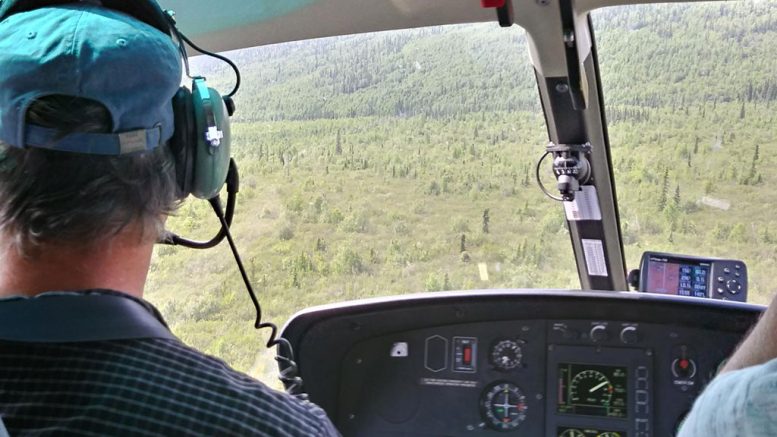Shawn Ryan’s White Gold (TSXV: WGO) has data from more than 400,000 Yukon soil samples, but one collected in the 2019 field season stood out by an order of magnitude.
“It actually kicked at over 100,000 parts per billion [ppb] gold,” Ryan said. “That’s right off the Richter scale for the ICP machines … we said, ‘the machine’s broken.’
“So they tried it again and again and again. Then we decided to fire-assay it, to see how far it goes past 100,000, which is 100 grams gold [per tonne]. When they flashed it through the fire assay it was 113 grams.”
Five ppb is the background level of gold-in-soil in the district and 35 ppb is in the 95th percentile of White Gold’s database. “I am happy if I have a soil anomaly that’s 50 ppb. So this rocked the boat pretty heavy.” (The next highest sample in the database contained 9,016 ppb gold, from the company’s Donahue target.)
After collecting grab samples grading up to 605 grams gold near the exceptional soil on its Hen property in the west-central Yukon, the company moved a rotary air blast (RAB) drill to the anomaly, which it named the Titan discovery. It drilled three holes before the end of the 2019 season. “One hole was right in the mag target. We weren’t quite sure if we hit anything. You could see in the XRF there was copper and bismuth, but you’re never sure if it has got gold in it.”
That hole returned 72.8 grams gold per tonne over 6 metres, from 11 metres’ depth, including 136.4 grams per tonne over 3 metres, within a 32-metre mineralized zone.
Ryan says Titan is unique because it’s associated with magnetite, unlike anything else he has seen in the region. “It looks and smells like skarn, but we’re not hanging our hat on that,” he says. “Whatever it is, it’s unusually high grade.”
“Next season we’ll probably get at least six to eight diamond drill holes in there because we see it magnetically, there are five other targets that are big mag balls in there. When you invert it, you can see it in 3-D and you’re going ‘holy crow.’”
Titan is just the latest in a series of shallow gold discoveries made by White Gold since Ryan founded the company in 2016.
In 2018 the company found Vertigo, 15 km east of Titan, when RAB drill results returned high-grade intercepts including 23.4 grams gold per tonne and 145 grams silver over 24 metres from surface. White Gold followed up in 2019 by hitting Vertigo with 9,500 metres of diamond drilling over 46 holes. Early results returned shallow gold mineralization including 4.3 grams gold per tonne over 12 metres, from 31 metres’ depth. All drill holes hit gold and the company has identified at least six high-grade structures that remain open in all directions.

The Titan discovery area on White Gold’s Hen property in west-central Yukon. Credit: White Gold.
Vertigo is on White Gold’s JP Ross property and the latest results suggest Vertigo is a structurally controlled mineralized zone and part of a larger system, which contains at least 10 other gold targets (of which only Vertigo has had diamond drilling), over a 250 sq. km trend. The company says Vertigo’s gold is hosted within a network of west-northwest-trending, moderate to steeply south dipping shallow structures that are subparallel to topography. High-grade mineralization is associated with quartz veining, brecciation and strong sericite-quartz alteration.
Highlight holes from other recent discoveries on White Gold’s land include 20.6 grams gold per tonne over 6 metres at Ryan’s Surprise, 3 grams gold over 10 metres at GS West and 1.1 grams gold over 50 metres at Betty.
The company also holds the advanced Golden Saddle and Arc deposits, which contain 14.3 million indicated tonnes grading 2.26 grams gold per tonne and 10.7 million inferred tonnes grading 1.48 grams gold for more than 1.5 million contained gold oz. across all categories. “The goal is to get it past the 2 million oz. mark, then the economics turn positive.” Ryan says this could take another one or two seasons of drilling.
In years past the graphitic Arc-style material was deemed problematic and was ignored. However, White Gold sent some Arc samples to 17.1% shareholder Agnico Eagle Mines (TSX: AEM; NYSE: AEM) for testing. Agnico has experience dealing with graphitic ore in Finland and got 85% gold recoveries from pretreated Arc material. “Agnico said, ‘the gloves are off, you can go after the Arc target now.’”
Results are pending from 6,000 metres of diamond drilling on the Golden Saddle and Arc deposits, which White Gold acquired from Kinross Gold (TSX: K; NYSE: KGC) in a vend-in deal that included $10 million in cash and a 19.9% stake in the junior. Kinross’ stake is now 17.1%.
White Gold’s model is to employ thorough, methodical exploration across its more than 400 sq. km land package — which covers more than 40% of the White Gold district — make discoveries and spin them out rather than pursuing resource delineation with the company.

A worker moves a GT Probe rock and soil sampling machine on White Gold’s property in the Yukon. Credit: White Gold.
Unlike many juniors, White Gold will not “throw money around like a machine gun” and rush into expensive diamond drilling campaigns before properly understanding a target, Ryan says. The company relies on innovative and economical techniques such as soil sampling and RAB drilling to identify and “flush out” targets.
“This is the only game where the norm is to fail … The only way to de-risk a project from failure is to do it right. Exploration is not just about geology or geophysics or geochemistry or structure — it’s about all four of those working together.
“You throw the sciences at it,” he says. “It’s like trying to drop the black ball in a pool game … you have to set your shots up.”
White Gold will only use a diamond drill once it’s confident it knows where to point it. “I don’t want anybody wasting money on our ground.”
Ryan says this method is based on what the major mining companies did in their exploration departments when he started in the industry in the late 1970s. And he says discoveries like the Vertigo prove it works.
“Vertigo was found under everybody’s noses. There’s roads going through there everywhere, they’ve been mining that creek for almost 120 years for placer gold and here we’re finding these new high-grade shoots — right off the road. We found four new ones right on the road, within 50 metres.”
Guy Gosselin, Agnico’s senior vice-president of exploration, says he is pleased with White Gold’s accomplishments and its “exploration recipe.”
“They have designed and adapted their method to be extremely efficient in the part of the world they are working in,” Gosselin says. “They cover a lot of ground and generate new targets at a very reasonable cost.”
Ryan says the White Gold district has the potential to become a major gold mining camp.

Rotary air-blast drillers on White Gold’s Betty gold target in the Yukon. Credit: White Gold.
“We’ve still never figured out where the 20 million oz. of placer gold came from. That’s what’s interesting about this JP Ross, it’s in Henderson Creek, a sub-belt from the Klondike gold fields, a unique placer area where about 80,000 oz. came out of. And now we’re finally finding the first physical evidence: narrow high-grade veins — and there’s a bunch of these. Can we make enough tonnage out of all of these? There’s a good probability because it’s all in one area.”
Ryan points out the Yukon government is helping build a haul road to Newmont Goldcorp’s (TSX: NGT; NYSE: NEM) nearby Coffee gold project. The road will pass by several White Gold properties, including JP Ross and Hen. “Once the road goes in and you get a couple of mills going over the next five to six years, it doesn’t matter what I find. Just like Timmins, if you find a half a million ounces you can truck it to one of the mills.”
“I come from the Timmins camp. I gotta remind people and myself that there you’re looking for gold 1,200 feet below surface and here I’m driving down these bush roads finding it on the road — welcome to the Yukon.”
White Gold shares have fluctuated between 73¢ and $1.69 in the past 52 weeks. At press time shares traded for $1.03, giving the company a $128-million market capitalization.






Be the first to comment on "White Gold keeps on discovering"